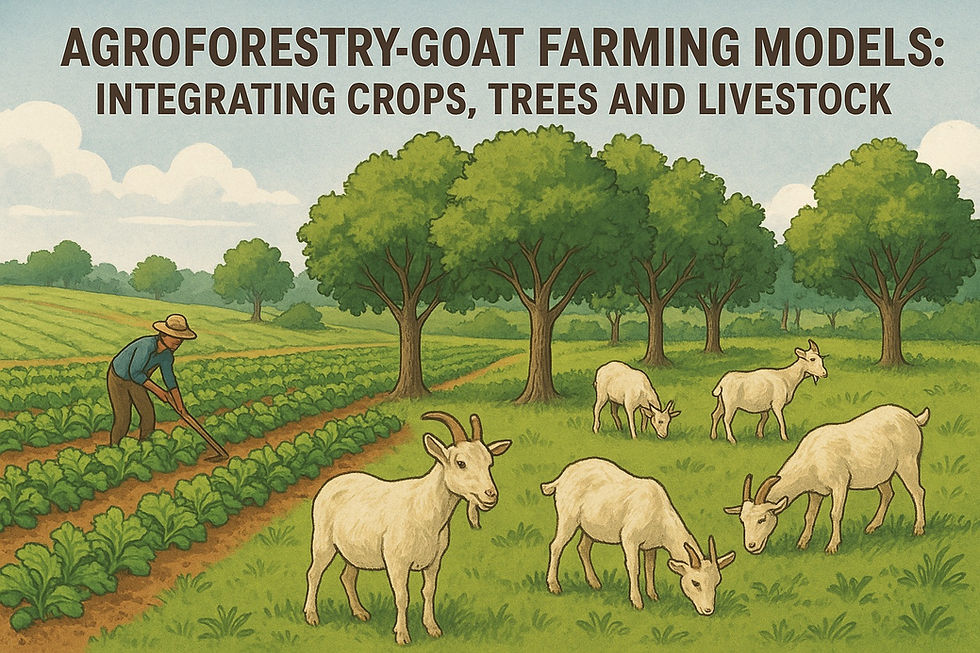Goat Farming in African Continent: Challenges & Opportunities
- Global Services TGT
- Feb 25
- 3 min read
Goat farming is an integral part of Africa’s agricultural landscape, providing a reliable source of food, income, and employment to millions of people. The sector plays a crucial role in enhancing food security and rural livelihoods while contributing to the continent’s economic growth. Given Africa’s vast rangelands and diverse climatic conditions, goat farming is a viable livestock enterprise. However, several challenges need to be addressed to unlock its full potential. This article examines the context, challenges and opportunities associated with goat farming in Africa.
Goat farming is widely practiced across the African continent, particularly in arid and semi-arid regions where other forms of livestock struggle to survive. Indigenous breeds dominate the sector, known for their resilience to harsh climates and ability to thrive on minimal resources. Goats are a primary source of meat, milk, hides, and manure for many rural households. Goats are also culturally significant, often used in traditional ceremonies and social transactions.
Despite its importance, goat farming in Africa remains largely informal, with limited commercialisation. Smallholder farmers form the backbone of the industry, rearing goats using traditional methods. While this ensures sustainability, it also limits productivity and profitability. Strengthening the sector requires strategic interventions in breeding, healthcare, market access, and financial support.
Challenges in Goat Farming:
Climate Change and Environmental Factors: Africa’s susceptibility to climate change poses a significant threat to goat farming. Prolonged droughts, erratic rainfall patterns, and desertification reduce pasture availability and water resources, leading to increased mortality and decreased productivity.
Disease and Poor Veterinary Services: Goat farming in Africa is affected by diseases such as Peste des petits ruminants (PPR), foot & mouth disease, and internal parasites. Limited access to veterinary services, vaccines, and proper disease management practices further complicates livestock health.
Low Productivity and Genetic Potential: Many African farmers rely on indigenous goat breeds that, while resilient, often have lower productivity in terms of meat and milk yield. The lack of improved breeding programs and access to superior genetics hampers commercial growth.
Limited Access to Quality Feed: The availability of quality feed and forage is often inconsistent, especially during dry seasons. Many small-scale farmers lack the knowledge or financial means to provide supplementary feeding, resulting in poor growth rates and reproductive performance.
Market Constraints and Poor Value Chains: Despite the demand for goat products, farmers face challenges in accessing profitable markets. Poor infrastructure, price fluctuations, and middlemen exploitation reduce farmers’ earnings. Lack of organised cooperatives and marketing strategies further limits profitability.
Financial Constraints and Lack of Credit Facilities: Many small-scale farmers struggle to access financing for expanding their operations. High interest rates, stringent loan requirements, and limited awareness of financial support programs hinder the growth of commercial goat farming.
Opportunities in Goat Farming:
Growing Demand for Goat Products: With increasing populations and urbanisation, the demand for goat meat, milk, and skin is on the rise. The popularity of goat meat as a source of protein and its cultural significance in many African communities create a steady market.
Resilience of Goats to Harsh Conditions: Unlike other livestock, goats are well-adapted to Africa’s dry and arid conditions. They can survive on low-quality forage and require less water, making them a viable option for livestock farming in challenging environments.
Introduction of Improved Breeds: The adoption of improved goat breeds with higher meat and milk yield presents a great opportunity. Crossbreeding programs and artificial insemination techniques can significantly enhance productivity.
Government and NGO Support: Several African governments and international organisations are promoting livestock farming through subsidies, training programmes, and improved veterinary services. These initiatives can help bridge knowledge gaps and provide financial assistance to farmers.
Value Addition and Agribusiness Potential: Processing Goat Meat into sausages, dried meat and other products, as well as developing dairy products like cheese and yogurt, can enhance profitability. Leather processing from goat skins also offers an opportunity for additional revenue streams.
Adoption of Modern Technologies: The use of mobile technology for market access, precision feeding techniques, and better disease management systems can transform goat farming into a more profitable and sustainable business.
Goat farming in Africa presents a mix of challenges and opportunities. While issues such as climate change, disease and market limitations exist, the sector holds immense potential for economic growth, food security and employment. By addressing these challenges through improved breeding, better healthcare, market integration, and policy support, Africa’s goat farming industry can thrive and contribute significantly to rural development and national economies.



Comments